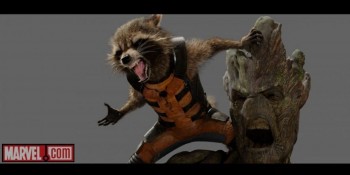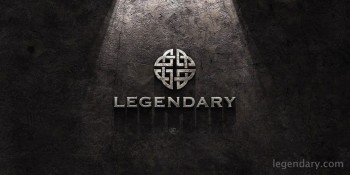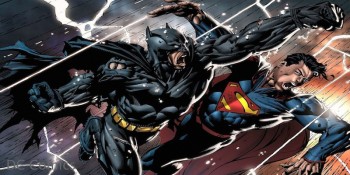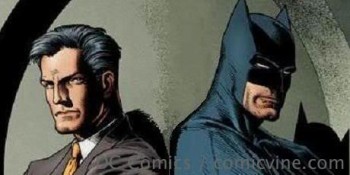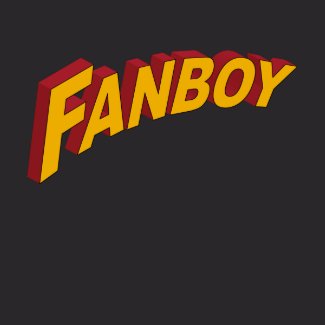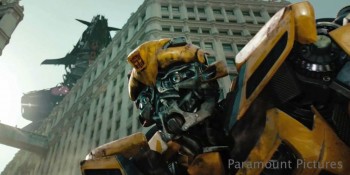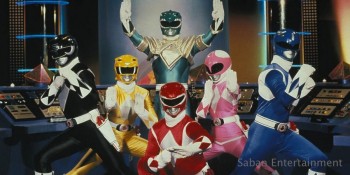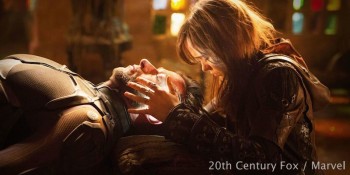I have a confession to make. I’ve proclaimed my love for all that is Marvel in this column on more than one occasion. I’ve shared how my original doubts over Chris Evans‘ casting as Captain America were proved wrong, and how the television series Agents of S.H.I.E.L.D. took a while to get off the ground but reached a late-season greatness that was definitely worth the wait.
But I must confess, despite all this evidence that Marvel knows what it’s doing when it comes to bringing comics to the silver screen (and Marvel is much more successful than Fox or Sony), I still had serious doubts when it came to bringing to life a trigger-happy raccoon and a walking, (sort of) talking tree. I’ve never actually read a Guardians of the Galaxy comic, but I know there are some things that work in comics that just can’t translate well to the screen, and I was worried this would be the case with Rocket and Groot.
I also had some doubts about Chris Pratt as a lead. I love Pratt — I’ve been a fan since his days on Everwood — but like Evans when he was cast as Captain America, Pratt was still very much untested as a protagonist. He has appeared as a supporting character in several films, but he is best known as goofy-yet-lovable Andy Dwyer on NBC’s Parks and Recreation. I wasn’t sure how he would go from that role to action star.
Another concern I had was with the movie itself. I had heard this was going to be unlike any other Marvel film, with a lot more humor. One of the things I love about the Marvel films is the way they use humor — it’s always just the right amount to balance the action. But would a funnier action film be good? I was a little worried they would cross the line over into slapstick and ruin the integrity of the franchise.
Plus, when you look at writer/director James Gunn‘s list of credits, you’ll see nothing of the caliber of a Marvel film. Like Pratt, Gunn is still rather untested in an arena this large, and I was concerned with how that might affect this film.
Amid all these concerns I was having about the film, while I was debating whether this was going to be a train wreck or the most awesome Marvel movie yet (because I had a feeling it was going to be either one or the other), the first trailer for the film was released.
To say that trailer made me a believer is probably an understatement. I think I fell in love with Pratt’s Peter Quill the moment he realized the name “Star Lord” meant nothing to his assailants. But I really knew this film had potential as soon as I heard “Hooked on a Feeling.”
Overall, this trailer ranks pretty high on my list of favorite trailers ever. (Please tell me someone else has one of those lists, too.) It also completely changed my mind about the prospects for the film. The trailer sets the tone of the movie and lets you know this isn’t going to be anything like the other Marvel productions. But it also proves that Rocket and Groot can work in a live-action film. I can’t even count how many times I watched that trailer or each subsequent teaser and trailer, but from that first glimpse on, I was counting down to the film’s release.
Last Thursday, I made plans to see Guardians in IMAX 3D with some friends, and I could barely contain my excitement. I surprised myself with how much my opinion of this film had changed in just six months. I was even more excited to discover that the film completely lives up to the hype.
I knew this was going to be a great movie before the opening credits were even finished; like the trailer, the credit sequence really set the tone for the entire film and let you know what you can expect. I loved all the ’80s references (Garbage Pail Kids! Troll Dolls! Footloose!) and the ’80s soundtrack was perfect. But it’s not all lighthearted and full of laughs — there are a couple tearjerker scenes, including one right at the beginning of the movie.
However, overall, the film is the perfect blend of hilarity and action. It is, by far, the funniest of the Marvel films, but it’s done in just the right way. At no point did it become too cheesy that the comedy took me out of the film. It has just the right amount of everything to make this the perfect summer movie — and really fun to watch.
In contrast to my reservations, Pratt is wonderful as Peter Quill, aka Star Lord. I had been binge-watching Parks and Recreation throughout the summer and was worried I would have trouble distinguishing between Quill and Andy, but I quickly discovered that wasn’t an issue at all. Pratt holds his own among a terrific cast and was an excellent choice for the role. I was also really impressed with part-time WWE performer Dave Bautista as Drax the Destroyer. He brought a lot of heart to the character, and I really enjoyed his portrayal.
Another stand-out performance, in my opinion, came from Karen Gillan as Nebula. Most fan*s are likely familiar with the actress as the Eleventh Doctor’s companion, Amy Pond. In Guardians, we see a whole new side to the actress’ talent. I’ve always like Gillan but was very impressed with her as Nebula, and I have a feeling she has a bright future ahead of her.
However, it was the characters I was originally most dubious about that ended up stealing every scene they were in. I absolutely loved Rocket and Groot. The CGI was done very well, and the characters were so expressive, you could almost forget they were animated. The entire cast (and movie) were fantastic, but I really think Rocket and Groot were my favorite parts.
There isn’t much else I can say about Guardians of the Galaxy that hasn’t already been said in hundreds of other reviews. As Marvel’s first film that is set almost entirely in space, it greatly expands the MCU as we know it, and it does this very successfully. I cannot wait for a future team-up between the Guardians and the Avengers (assuming the rumors are true and Avengers 3 features a version of the Infinity Gauntlet storyline, which, given the reference to the Stones in Thor: The Dark World and again in Guardians, seems likely). I’m already imagining Tony Stark’s comments about Rocket and Groot.
I may have been skeptical at first, but after seeing what the company did with Guardians, I will never again doubt Marvel’s ability to produce great films. Now that Phase Two is nearly over, I can’t wait to see what they have in store for us in Phase Three, and I can’t wait until the Guardians of the Galaxy return.
